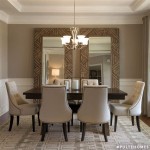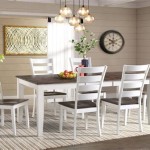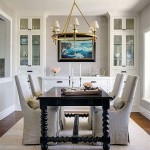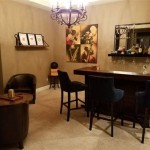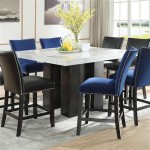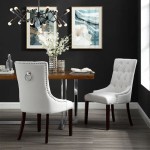Dining Room Tables For 12 People: A Comprehensive Guide
Selecting a dining room table for 12 people requires careful consideration of factors beyond mere aesthetics. The table must be functional, durable, and appropriately sized for the designated space. This article explores key aspects of choosing a dining room table that comfortably accommodates 12 individuals, covering style considerations, size and shape guidelines, material options, and practical considerations for long-term use and maintenance.
Understanding Space Requirements and Table Size
The primary determinant in selecting a dining table for 12 is the available space within the dining room. Accurate measurements are crucial. One must account not only for the table's footprint but also for adequate clearance around the table to allow comfortable movement for diners and serving staff. As a general rule, a minimum of 36 inches (91 cm) of space should be maintained between the edge of the table and any wall or other furniture. This allows individuals to easily pull out chairs and navigate the area without obstruction.
Considering these clearance requirements, a typical dining room table for 12 people will be significantly larger than standard dining tables. Rectangular tables designed for 12 typically range from 96 to 120 inches (244 to 305 cm) in length and 40 to 48 inches (102 to 122 cm) in width. Oval tables, another suitable option, often fall within a similar size range. Round tables for 12 require substantial diameter, typically exceeding 72 inches (183 cm), and may present challenges in conversation due to the distance between individuals seated opposite each other.
Before committing to a specific size, it is advisable to physically mark the planned table dimensions on the floor using tape or cardboard. This allows for a realistic visualization of the table's presence within the room and helps assess whether sufficient space remains for comfortable movement and other furniture. It also aids in identifying potential obstructions, such as doorways, windows, or heating vents.
Furthermore, it's essential to consider the table's height. Standard dining table height is typically around 30 inches (76 cm). Selecting chairs with appropriate seat height relative to the table is vital for comfortable dining. The ideal gap between the seat and the table's underside should be around 12 inches (30 cm) to allow ample legroom.
Exploring Table Shapes and Styles
The shape of a dining table impacts both its functionality and its aesthetic appeal. Rectangular tables are the most common choice for seating larger groups, offering a linear configuration that maximizes space utilization. They are well-suited for both formal and informal dining settings. Oval tables provide a similar seating capacity but with softer lines, promoting a more intimate and conversational atmosphere. The absence of sharp corners also makes them a safer option, particularly in households with young children.
Round tables, while aesthetically pleasing, are less efficient in terms of space utilization, especially in rectangular rooms. The substantial diameter required to accommodate 12 individuals can make them impractical for smaller dining areas. Square tables are rarely used for large groups due to their limited seating capacity and potential for restricted legroom at the corners.
Beyond shape, the style of the table should complement the overall décor of the dining room. Traditional dining rooms often feature tables crafted from solid wood, with ornate carvings and elaborate legs. These tables typically exhibit a rich, warm finish. Contemporary dining rooms may favor tables with clean lines, minimalist designs, and materials such as glass, metal, or engineered wood. Transitional styles bridge the gap between traditional and contemporary, incorporating elements of both.
Pedestal tables, which feature a central support instead of four legs, can offer more legroom for diners, particularly when accommodating a large group. However, it's crucial to ensure that the pedestal base is sufficiently sturdy to support the weight of the table and its occupants. Trestle tables, with their distinctive supporting beams, can add a rustic or farmhouse charm to a dining room. Extendable tables, also known as leaf tables, offer versatility by allowing the table's size to be adjusted as needed. This can be particularly useful when accommodating smaller groups on a regular basis while still having the option to seat 12 when required.
The choice of table style should also reflect the architectural style of the home. A modern, minimalist house might benefit from a sleek, glass-topped table with metal legs, while a more traditional home would likely be better suited to a solid wood table with a classic design.
Considerations for Material Durability and Maintenance
The material of a dining table significantly impacts its durability, maintenance requirements, and overall aesthetic. Solid wood tables are prized for their beauty, strength, and longevity. Hardwoods, such as oak, maple, and cherry, are particularly durable and resistant to scratches and dents. Softwoods, such as pine, are more susceptible to damage but can be a more affordable option. Wood tables require regular cleaning and occasional polishing to maintain their appearance. They are also vulnerable to water damage and should be protected from spills.
Veneer tables, which consist of a thin layer of wood applied over a core material, offer a more cost-effective alternative to solid wood. While veneer tables can be aesthetically pleasing, their durability is generally lower than that of solid wood tables, and they are more prone to chipping and peeling. Engineered wood tables, such as those made from MDF (medium-density fiberboard) or particleboard, are another affordable option. These tables are typically less durable than solid wood or veneer tables and may not be suitable for heavy use.
Glass-topped tables offer a modern and elegant look. They are easy to clean and maintain but can be susceptible to scratches and chips. Tempered glass is a stronger and more durable option than regular glass. Metal tables, particularly those made from stainless steel or wrought iron, are highly durable and resistant to damage. They are often used in contemporary dining rooms. However, metal tables can be heavy and may require special care to prevent rusting or corrosion.
The finish applied to a dining table also plays a crucial role in its durability and maintenance. A durable finish, such as polyurethane or lacquer, can protect the table from scratches, spills, and stains. Matte finishes tend to show less wear and tear than glossy finishes. It is important to choose a finish that is appropriate for the intended use of the table. For example, a table that will be used for everyday dining should have a more durable finish than a table that will only be used for occasional entertaining.
Ultimately, the choice of material should be guided by a balance of aesthetics, budget, and desired level of durability and maintenance. Consider the frequency of use, the potential for spills and accidents, and the time and effort one is willing to invest in maintaining the table's appearance.
Beyond the table itself, the choice of chairs is equally important. The chairs should be comfortable, durable, and appropriately sized for the table. Consider the style of the chairs in relation to the table and the overall décor of the dining room. Armchairs can provide added comfort but may require more space. Upholstered chairs can add a touch of luxury but may be more difficult to clean. It's wise to select chairs with durable upholstery that is stain-resistant and easy to maintain.
Lighting plays a crucial role in creating the right ambiance in a dining room. A chandelier or pendant light positioned above the table can provide both functional and decorative lighting. Dimmable lights allow for adjusting the brightness to suit different occasions. Consider the size and style of the lighting fixture in relation to the table and the overall décor of the room.
Finally, consider accessories such as tablecloths, placemats, and centerpieces. These can add a touch of personality and style to the dining table. Choose tablecloths and placemats that are easy to clean and resistant to stains. Centerpieces can be simple or elaborate, depending on the occasion. Fresh flowers, candles, or decorative bowls can all make attractive centerpieces.

Hartford Trestle Extension Table

48 X96 Oval Tables Seats 12 14 People Event Rentals Nyc Brooklyn

Herrington Dining Chair

Round Scalloped Fluted Pedestal Dining Table Diy Seats 10 12 People Black Ink Oak Finish

Large Dining Table Seats 10 12 14 16 People Huge Big Tables

Expert Advice How To Design A Perfectly Scaled Dining Room The Kuotes Blog

Table Seating Capacity Contemporary Craftsman Furniture

Expert Advice How To Design A Perfectly Scaled Dining Room The Kuotes Blog

Ash Wood Stainless Steel Dining Tables You Ll Love In 2025 Homary

Amish Table Size Guide What Dining Do You Need

